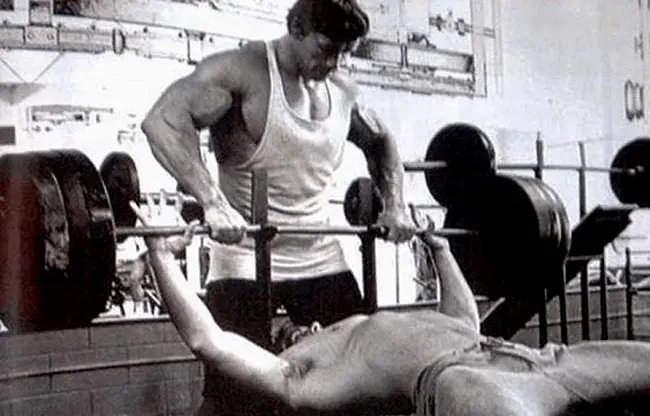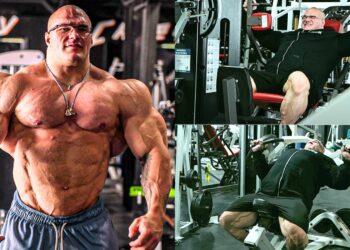When it comes to designing the perfect training program, there are a lot of things you need to consider. Factors you must think about include:
- Training frequency
- Weekly training volume
- Split routine or full-body workouts
- Number of exercises per workout
- Rep range
- Load allocation
- Rest periods between sets
- Training tempo
- Proximity to failure
- Etc.
However, arguably the most important consideration is workout specificity. Your program MUST match your training goal. For example, it doesn’t matter how well-designed your workout is; if it doesn’t match your training goal, you WILL NOT get the results you seek.
That’s because your body adapts to the stresses placed upon it, and those stresses determine your results.
As such, there is a right and wrong way to train for any fitness goal.
Want to run faster? Then run fast during training! Want to be more flexible? You need to stretch more! Want to jump higher? Powerful leaps MUST be part of your workouts.
Despite the rule of specificity, many people are still confused about how to train for hypertrophy vs. how to train for strength. While there are overlaps between these two training goals, they can also be achieved somewhat separately.
Level Up Your Fitness: Join our 💪 strong community in Fitness Volt Newsletter. Get daily inspiration, expert-backed workouts, nutrition tips, the latest in strength sports, and the support you need to reach your goals. Subscribe for free!
In this article, we discuss how training for hypertrophy and strength differ, so you can choose the best approach for your goals.
What is Hypertrophy?
Hypertrophy means the enlargement of an organ or tissue, and in hypertrophy training refers to increasing muscle size. Bodybuilders train almost exclusively for hypertrophy, as they’re trying to increase the size of their muscles and have little or no interest in athletic performance.
Muscles get bigger in response to a combination of factors. A well-designed hypertrophy training program needs to include:
Moderate to high training volume
While there are some low-volume hypertrophy training programs, most bodybuilders do multiple sets of multiple exercises for each muscle group. While training volume varies from lifter to lifter, most do 12-20 sets per muscle group per week, with higher volumes often being best for muscle growth (1).
Muscle tension
Exercises are selected to place tension on the target muscle or muscles. Ideally, tension should be high throughout the entire range of motion. Muscle tension causes micro trauma to the muscles, literally breaking them down so the grow back bigger and stronger.
Bodybuilders use strategies to increase muscle tension, such as a stronger mind-muscle connection, mid-rep pauses, a controlled lifting/lowering tempo, and isolation exercises. More tension should produce more muscle growth.
Metabolic stress
This refers to the accumulation of metabolic waste products in a muscle as it begins to fatigue, including lactic acid. Metabolic stress, characterized by burning in the muscle as you near the end of your set, is thought to be a trigger for increased growth factor and anabolic hormone production (2).
These three factors are responsible for two types of muscle hypertrophy. On the one hand, they cause the muscle fibers to thicken and increase in number. This is called myofibril hypertrophy. Myofibril hypertrophy makes muscles bigger and also increases their strength potential.
Hypertrophy training also triggers something called sarcoplasmic hypertrophy. This is the accumulation of non-contractile fluid within the muscle. Sarcoplasmic hypertrophy makes your muscles bigger but has no effect on strength.
Training for Hypertrophy
Training for hypertrophy usually involves a split workout approach, where different muscles are trained on different days. Depending on the split chosen, this can involve working each muscle anywhere from one to three or more times per week.
Example splits include:
| Monday | Tuesday | Wednesday | Thursday | Friday | Saturday | Sunday |
| Push | Pull | Legs | Push | Pull | Legs | Rest |
| Or: | ||||||
| Upper | Lower | Rest | Upper | Lower | Rest | Rest |
| Or: | ||||||
| Chest | Back | Rest | Legs | Shoulders | Arms | Rest |
To ensure they work every muscle from all the available angles to affect the maximum number of muscle fibers, most bodybuilders train each body part with multiple exercises.
For example:
- Bench press
- Incline dumbbell bench press
- Dumbbell flies
- Dips
- Chest press machine
Using multiple exercises per body part also makes achieving the required level of training volume for hypertrophy much easier. Without using multiple exercises, you’d have no choice but to do lots of sets of the same exercise, which would prove boring.
Bodybuilders tend to train with moderate to light weights for medium to high reps. For many years, this meant staying in the 6-12 repetition range.
However, recent studies suggest that hypertrophy can be achieved with higher reps and even lower loads (3). This means the workable rep range for hypertrophy is actually more like 6 to 20-30 reps.
To trigger hypertrophy, sets need to be taken close to failure. Submaximal sets, where you stop more than 3-5 reps shy of failure, are not as effective for muscle growth. Hypertrophy training also involves short, incomplete rests to ensure the muscle does not recover completely between sets to maximize metabolic fatigue.
What is Strength?
Strength is the amount of force generated by a muscle or muscle group. It’s normally expressed as your one-repetition maximum, or 1RM for short. This is the amount of weight you can lift once but not twice. However, some athletes prefer to test their 2RM, 3RM, or 5RM.

Motor unit recruitment
Muscles are made up of bundles of muscle fibers. These fibers are grouped into motor units, which are sets of fibers controlled by a single nerve called a motor neuron. Some muscles have a lot of motor units, while others have fewer.
Motor units work according to the all-or-nothing law. They either work with 100 of their contractile ability or do not contract at all. The more motor units you can activate simultaneously, the more force you’ll be able to generate and the stronger you’ll be.
Motor unit recruitment is a neurological skill. With training, you can learn to switch on more motor units and produce greater force, even if your muscles don’t get any bigger.
Rate coding
This refers to the speed at which neurons send innervating signals to the muscle fibers (4). Like motor unit recruitment, this is a neurological skill that can be improved with appropriate training. The faster you can fire up your motor units, the more force you’ll be able to generate.
Hypertrophy
Larger muscles have a greater POTENTIAL for strength. However, strength is also determined by neurological factors like motor unit recruitment and rate coding.
As such, it IS possible for a smaller muscle to be stronger than a bigger muscle simply because it’s been trained for force generation and muscle recruitment is more efficient.
Proficiency
Strength is a skill, and the more practiced you are at a movement, the better your performance is likely to be. For this reason, strength athletes such as powerlifters and Olympic weightlifters spend a lot of time perfecting their technique.
Your performance, i.e., the amount of weight lifted, will often increase simply because you become more technically proficient at an exercise.
Training for Strength
Where training for hypertrophy tends to revolve around targeting individual muscles and muscle groups, strength training focuses more on movements. That’s because most feats of strength involve specific exercises, such as the squat, bench press, deadlift, or overhead press.
Strength athletes still use split routines, but rather than targeting different muscle groups on different days, it’s the movements that vary.
Level Up Your Fitness: Join our 💪 strong community in Fitness Volt Newsletter. Get daily inspiration, expert-backed workouts, nutrition tips, the latest in strength sports, and the support you need to reach your goals. Subscribe for free!
For example:
| Monday | Tuesday | Wednesday | Thursday | Friday | Saturday | Sunday |
| Squat & accessory exercises | Bench press & accessory exercises | Rest | Deadlift & accessory exercises | Overhead press & accessory exercises | Rest | Rest |
So, as well as focusing on the main lift of the day, a strength workout will probably include several accessory or assistance exercises chosen to increase the performance of the primary lift, prevent injuries, and address muscle imbalances.
As a rule, strength workouts tends to revolve around fewer exercises than training for hypertrophy. Exercise variety is not viewed as an essential part of building strength. Instead, most strength workouts revolve around a handful of staple exercises, usually the squat, bench press, deadlift, and overhead press.
That’s because these exercises stimulate the maximum number of muscle groups, allow for the greatest amount of weight to be lifted, and train the body as it works in nature.
While reps and load are highly variable for building bigger muscles, strength is best developed using heavy weights and low reps. Typically, strength workouts are built around 1-5 reps per set using 85% or more of the 1RM for the programmed main lifts.
Low reps are often accompanied by a high number of sets – sometimes as many as eight or more. This provides the volume necessary to truly master the chosen exercise. However, not all sets will be done using maximal weights. The lifter may “ramp up” over several sets to their maximum weight for the day.
For example:
- 1st set – 5 reps with 100kg
- 2nd set – 5 reps with 110kg
- 3rd set – 5 reps with 120kg
- 4th set – 5 reps with 135kg
- 5th, 6th, and 7th set – 5 reps with 150kg (max for the day)
Lifting heavy weights for low reps is accompanied by long rests between sets, typically 3-5 minutes. Such long rests are necessary for the nervous system AND the muscles to recover fully. This will allow for the heaviest weights possible to be used during training.
It’s worth noting that assistance exercises are often performed using lighter weights and lower reps for variety and to avoid over-taxing the central nervous system. Assistance exercises are often programmed similarly to bodybuilding training, i.e., light to moderate weights and medium to high reps.
Hypertrophy vs. Strength Comparisons
To save you looking back and forth between the previous two sections, let’s compare the main features and components of hypertrophy and strength training.
Program Design
Where bodybuilders tend to use a muscle-by-muscle approach to program design, strength athletes focus more on movements or the specific lifts they want to improve. So, while bodybuilders often have a chest day or an arms day, training for strength is more likely to be built around squat days and deadlift days.
Strength and hypertrophy training can use split routines or full-body workouts, depending on training preferences and time available for working out.
Exercise Selection
Strength athletes tend to plan their workouts around a small number of key lifts, sometimes as few as 1-2. Invariably, these are compound exercises such as the squat, bench press, deadlift, and overhead press. This means they can really focus on not just building strength but also mastering each exercise for optimal performance.
In contrast, hypertrophy workouts usually involve a wider range of exercises to ensure complete stimulation of all available muscle fibers and hit the muscle from multiple angles.
Also, where a muscle has more than one function, exercises are chosen to ensure both functions are replicated in the workout. For example, the lats extend and adduct the shoulder joint, so a back workout will probably include both rowing and lat pulldown/pull-up variations.
Sets and Reps
You can build muscle using almost any rep scheme, providing you take your sets to within a couple of reps of failure. That means the workable rep range for hypertrophy is anywhere from 6 to 20-30 reps per set.
Hypertrophy is usually best achieved with a high volume of sets per week – typically 12-20 per muscle group. These sets can be completed in one workout, but it’s generally best to spread them out over 2-3 workouts.
In contrast, training for strength involves lifting heavy weights for low reps, typically 85% or more of your 1RM for 1-5 reps per set. Volume is usually a little lower than for hypertrophy, with strength athletes performing 3-8 sets per main lift. However, assistance exercises can follow hypertrophy guidelines.
Rest Periods
Lifting heavy weights is very taxing for the nervous system. As successful strength training is dependent on lifting near maximal loads, rest periods tend to be quite long – typically 3-5 minutes or more. In some cases, where very heavy loads are used, lifters may rest 10-15 minutes between sets.
As performance is not such an issue with hypertrophy training, and sets are not as neurologically taxing, bodybuilders tend to use shorter rests, usually between 30-90 seconds.
In general, the smaller the muscle group being trained, the shorter the rests can be. Also, rest periods are usually shorter for isolation exercises than the more taxing compound exercises.
Hypertrophy vs. Strength – Summary
| Hypertrophy | Strength | |
| Load | 40-80% 1RM | 85%+ 1RM |
| Rep range | 6-20 | 1-5 |
| Exercises per workout | 4-8 | 1-5 |
| Sets per muscle group | 12-20 | 3-8 |
| Rest periods | 30-90 seconds | 3-5 minutes+ |
| Type of exercise | Compound and isolation | Mostly compound |
| Program split | Body part split | Movement-based split |
Can You Train for Both?
Hypertrophy and strength training require very different workout approaches. However, many exercisers want to be big AND strong and want to combine both of these elements.
Training to increase strength and muscle size is called powerbuilding.
A powerbuilding program involves low rep, heavyweight training to increase maximal strength and lighter weight, higher rep training to trigger hypertrophy (muscle growth).
Squats, bench presses, and deadlifts are cornerstones of this type of training, but classic bodybuilding exercises are also included to increase training volume and time under tension and the muscle microtrauma (muscle damage) and exercise variety necessary for building muscle mass.
Here’s an example lower body power building workout:
| Exercise | Sets | Reps | Recovery | |
| 1 | Deadlifts | 5 | 3-5 | 3 minutes |
| 2 | Leg press | 4 | 6-8 | 3 minutes |
| 3 | Romanian deadlifts | 3 | 8-10 | 2 minutes |
| 4 | Leg extension | 3 | 10-12 | 2 minutes |
| 5 | Bulgarian split squats | 2 | 12-15 per leg | 90 seconds |
With power building, you’ll neither maximize strength nor muscle size but instead get decent amounts of both. Power building is ideal for athletes and anyone who wants to build functional muscle mass.
Hypertrophy vs. Strength – Wrapping Up
Muscle size and strength do not exist in a vacuum. Training for strength will lead to increases in muscle size, and you’ll also get stronger if you train for hypertrophy. There is a definite overlap between these different styles of training.
That said, because of the law of specificity, if you want to maximize strength or hypertrophy gains, your training should be aligned with your goals. That means lifting heavy weights for low reps for strength and moderate to light weights with a high volume of training for hypertrophy.
However, unless you are solely interested in muscle size OR strength, most people don’t need to specialize in one type of training or the other, and may do best by following the power-building approach to training, building muscle size and strength in equal measure.
Regardless of which type of training you choose, make sure your program matches your goals. Otherwise, you could end up wasting a whole lot of time and energy on workouts that take you in entirely the wrong direction.
Finally, remember your diet and lifestyle needs to support your workouts. Food and sleep will have a massive impact on your progress, even if you follow a perfect program.
References:
1. PubMed: Dose-response relationship between weekly resistance training volume and increases in muscle mass: A systematic review and meta-analysis https://pubmed.ncbi.nlm.nih.gov/27433992/
2. PubMed: Role of metabolic stress for enhancing muscle adaptations https://www.ncbi.nlm.nih.gov/pmc/articles/PMC5489423/
3. PubMed: Effects of different intensities of resistance training with equated volume load on muscle strength and hypertrophy https://pubmed.ncbi.nlm.nih.gov/29564973/
4. PubMed: Rate coding and the control of muscle force https://www.ncbi.nlm.nih.gov/pmc/articles/PMC5629984/













